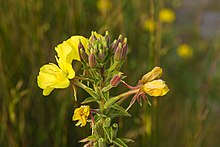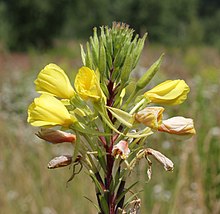Oenothera biennis
 From Wikipedia the free encyclopedia
From Wikipedia the free encyclopedia
| Oenothera biennis | |
|---|---|
 | |
| Scientific classification | |
| Kingdom: | Plantae |
| Clade: | Tracheophytes |
| Clade: | Angiosperms |
| Clade: | Eudicots |
| Clade: | Rosids |
| Order: | Myrtales |
| Family: | Onagraceae |
| Genus: | Oenothera |
| Species: | O. biennis |
| Binomial name | |
| Oenothera biennis | |
| Synonyms[2] | |
| |
Oenothera biennis, the common evening-primrose,[3] is a species of flowering plant in the family Onagraceae, native to eastern and central North America, from Newfoundland west to Alberta, southeast to Florida, and southwest to Texas, and widely naturalized elsewhere in temperate and subtropical regions.[4] Evening primrose oil is produced from the plant.[5]
Other common names include evening star, sundrop, weedy evening primrose, German rampion, hog weed, King's cure-all and fever-plant.[5][6]
Description
[edit]
Oenothera biennis usually has a life span of two years (biennial) growing to 1.6 m (5 ft 3 in) tall in the seeding year.[7] The leaves are lanceolate, 8–18 cm (3–7 in) long and 2–6 cm (3⁄4–2+1⁄4 in) wide,[7] produced in a tight rosette the first year, and spirally on a stem the second year. However, plants with annual life cycles are documented, and have been selected for under experimental conditions in environments with low competition.[8]
Growing cycle
[edit]Most commonly, O. biennis grows as a low, spreading herb in the first year, just a few centimetres tall, with its leaves spreading out in a rosette to cover the ground, whilst storing energy in a thick root. In the second year, it grows up much taller, to around 1.6 metres (5.2 ft) tall, on a semi-woody stem, which then flowers and seeds. This will usually die at first frosts, but occasionally grows another stem in the third year.
Blooming and fruiting
[edit]Blooming lasts from late spring to late summer. The flowers are hermaphrodite, produced on a tall spike and only last until the following noon. They open visibly fast every evening producing an interesting spectacle, hence the name "evening primrose".
The blooms are yellow, 2.5–5 cm (1–2 in) diameter, with four bilobed petals. The flower structure has a bright nectar guide pattern, invisible to the naked eye. This pattern is apparent under ultraviolet light and visible to its pollinators, moths, butterflies, and bees.
The fruit is a capsule 2–4 cm (3⁄4–1+1⁄2 in) long and 4–6 mm (0.16–0.24 in) broad, containing numerous 1–2 mm (0.04–0.08 in) long seeds, released when the capsule splits into four sections at maturity.[9][10][11][12]



Ecology
[edit]This plant is a weedy species that favors disturbed environments.[13][14] It has been introduced and become established on all continents except Antarctica.[15]
The seeds of the plant are important food for birds,[16] including American goldfinch, Northern bobwhite, and mourning dove, and it is a larval host for both the primrose moth and the white-lined sphinx moth.[17] Bumblebees and honeybees also visit the flowers.[13]
The primrose moth (Schinia florida) is a common consumer of Oenothera biennis. The adults lay eggs on the flower, and the emerging caterpillars feed on the plant.


The seeds of O. biennis can remain viable in the soil seed bank for 70 years or more.[13][15]
Uses
[edit]Over the centuries, Indigenous people in North America have used the plant as food and traditional medicine.[5][18]
The evening primrose was introduced to Europe in the early 17th century as an ornamental plant in botanical gardens where its flowers are favored for nectar by pollinators, such as bees, and its seeds are food for birds.[5][18]
Food uses
[edit]Most of the plant parts are edible, having a taste that is mild.[18] The roots can be eaten raw or cooked like potatoes.[18] The leaves can be eaten raw in salads or cooked like spinach or in soups.[18] Anishinaabe tribes traditionally make tea from the evening primrose leaves for use as a dietary aid and to reduce fatigue.[18]
The flowering stems are preferably used when they are still young in June. They have to be peeled and can then be eaten raw or fried. The flower buds are regarded as a delicacy and can be harvested from June to October.[18]
The seeds have a protein content of about 15%, an oil content of 24%, and contain about 43% cellulose.[19] The proteins are especially rich in the sulphur-containing amino acids, methionine and cysteine, and tryptophan.[19][20] Gamma-linolenic acid (GLA), and linoleic acid are present.[18][21][22] Mainly for these polyunsaturated fatty acids, evening primrose oil is sold as a dietary supplement.[18]
Research
[edit]There is not enough clinical evidence to support the use of evening primrose oil as a therapy for any medical condition.[5] A Cochrane review concluded that there was no effect of primrose oil on eczema.[23] The Mayo Clinic stated there was no good evidence that it affected eczema, diabetic neuropathy or premenstrual syndrome.[24]
The American Cancer Society stated that there was little evidence for its effectiveness as an anti-cancer agent, for which it is sometimes promoted, and "neither GLA nor other GLA-rich supplements (such as evening primrose oil) have been convincingly shown to be useful in preventing or treating any other health conditions."[25]
Adverse effects
[edit]Evening primrose oil is considered likely as safe in recommended doses.[5][24] It may increase the risk of bleeding, a concern for patients with bleeding disorders or taking drugs that may increase bleeding.[5] The Mayo Clinic recommends caution in people with seizure disorders or mania, and by pregnant or breastfeeding women, and publishes a long list of possible side-effects.[24] Oral use of evening primrose oil may cause headaches or nausea.[24]
Traditional medicine
[edit]The whole plant and especially the leaves are traditionally boiled to tea by Anishinaabe tribes as an energy stimulant and to facilitate weight loss.[5] These tribes also use the roots externally as a poultice to treat piles and boils.[5] Additionally, they may be chewed and rubbed onto the muscles to improve strength.[18]
Agricultural practices
[edit]The knowledge of agricultural practices in the cultivation of evening primrose is relatively new and only pertain to the commercialized production of evening primrose seed oil. Information of agricultural practices for the production of root vegetable or other plant parts is not known yet.
The evening primrose prefers sunny, and arid places with loamy soil and occurs below 700 metres (2,300 ft) above sea level.[18] One important prerequisite is to meet adequate nitrogen requirements. While too high nitrogen levels could lead to a quality and quantity decline of the oil content in the seeds, moderate nitrogen levels lead to increased seed quality and quantity.[21] Because the evening primrose is a light-dependent germinator, it is important that the seeds are not planted too deep into the soil, about 0.5–1.0 centimetre (0.2–0.4 in) deep. The cultivation of evening primrose is thus suitable for no-till farming, but the plants require an intense mechanical weed control. The seeds are tiny, about 0.3–0.7 grams (0.011–0.025 oz). They need approximately two to three weeks to germinate and are therefore very susceptible to the outgrowth of weeds.
Evening primrose seeds can be sown in the first half of April (spring seeds) or from mid-July to mid-August (autumn seeds).[18][21] The time of harvest is approximately 75 to 80 days (spring seeds) or 100 days (autumn seeds) after flowering, and clearly influenced by the plant variety, climate conditions, soil fertility and sowing time.[21][22] The population development and thus seed maturation of the evening primrose is very heterogeneous which is a rather difficult production factor.[18]
There is not much water needed during the vegetation period.[18] A study has shown, that the irrigation with salt water could increase the oil yield and quality in evening primrose seeds. This might be a great opportunity especially in regions with limited water resources. Thus, the evening primrose could be a valuable alternative oil crop in arid regions.[18]
Finally, the cultivation of evening primrose requires a proper field management otherwise the plant can become invasive.[18] If the seeds are used for pharmaceutical purposes it is also important to grow the evening primrose without any pesticides to avoid any chemical residues.[18]
- Rosette
- Flowers and fruit capsules
- Primrose moth (Schinia florida) in flower
- Habitat, dry and sunny
References
[edit]- ^ "NatureServe Explorer 2.0". explorer.natureserve.org.
- ^ "Oenothera biennis". World Checklist of Selected Plant Families. Royal Botanic Gardens, Kew. Retrieved 7 December 2014 – via The Plant List. Note that this website has been superseded by World Flora Online
- ^ BSBI List 2007 (xls). Botanical Society of Britain and Ireland. Archived from the original (xls) on 2015-06-26. Retrieved 2014-10-17.
- ^ "Oenothera biennis". Germplasm Resources Information Network. Agricultural Research Service, United States Department of Agriculture. Retrieved 17 December 2017.
- ^ a b c d e f g h i "Evening primrose oil". National Center for Complementary and Integrative Health, US National Institutes of Health. 1 August 2020. Retrieved 3 August 2022.
- ^ Blanchan, N. (1922). Wild Flowers Worth Knowing. Project Gutenberg Literary Archive Foundation.
- ^ a b Elias, Thomas S.; Dykeman, Peter A. (2009) [1982]. Edible Wild Plants: A North American Field Guide to Over 200 Natural Foods. New York: Sterling. p. 103. ISBN 978-1-4027-6715-9. OCLC 244766414. Archived from the original on 2022-03-20. Retrieved 2021-01-08.
- ^ Agrawal, Anurag A.; Johnson, Mark T.J.; Hastings, Amy P.; Maron, John L. (2013). "A Field Experiment Demonstrating Plant Life-History Evolution and Its Eco-Evolutionary Feedback to Seed Predator Populations". The American Naturalist. 181: S35-45. doi:10.1086/666727. hdl:1813/66733. PMID 23598358. S2CID 15852492.
- ^ Borealforest: Oenothera biennis Archived 2007-07-13 at the Wayback Machine
- ^ Plants of British Columbia: Oenothera biennis Archived 2016-12-21 at the Wayback Machine
- ^ Jepson Flora: Oenothera biennis Archived 2006-09-18 at the Wayback Machine
- ^ Ultraviolet Flowers: Oenothera biennis Archived 2006-11-14 at the Wayback Machine
- ^ a b c "Common Evening Primrose (Oenothera biennis)". illinoiswildflowers.info.
- ^ "Oenothera biennis (Evening Primrose)". plants.ces.ncsu.edu. NC State Extension.
- ^ a b Steckel, Lawrence E.; Sosnoskie, Lynn M.; Steckel, Sandra J. (2019). "Common evening-primrose (Oenothera biennis L.)". Weed Technology. 33 (5): 757–760. doi:10.1017/wet.2019.53. S2CID 203879053.
- ^ "Oenothera biennis". Native Plant Database. Lady Bird Johnson Wildflower Center, University of Texas at Austin. Retrieved 7 December 2014.
- ^ The Xerces Society (2016), Gardening for Butterflies: How You Can Attract and Protect Beautiful, Beneficial Insects, Timber Press.
- ^ a b c d e f g h i j k l m n o p q Immel, D.L. (21 June 2001). "Common evening primrose" (PDF). United States Department of Agriculture, National Plant Data Center.
- ^ a b Hudson, B. (1984). "Evening primrose (Oenothera spp.) oil and seed". Journal of the American Oil Chemists' Society. 61 (3): 540–543. doi:10.1007/bf02677026. S2CID 85005706.
- ^ Brosnan, J.T.; Brosnan, M.E. (2006). "The sulfur-containing amino acids: an overview". The Journal of Nutrition. 136 (6): 1636S–1640S. doi:10.1093/jn/136.6.1636s. PMID 16702333.
- ^ a b c d Ghasemnezhad, A.; Honermeier, B. (2008). "Yield, oil constituents, and protein content of evening primrose (Oenothera biennis L.) seeds depending on harvest time, harvest method and nitrogen application". Industrial Crops and Products. 28 (1): 17–23. doi:10.1016/j.indcrop.2007.12.006.
- ^ a b Ghasemnezhad, A.; Honermeier, B. (2007). "Seed yield, oil content and fatty acid composition of Oenothera biennis L. affected by harvest date and harvest method". Industrial Crops and Products. 25 (3): 274–281. doi:10.1016/j.indcrop.2006.12.005.
- ^ Bamford, Joel (30 April 2013). "Oral evening primrose oil and borage oil for eczema". Cochrane Database of Systematic Reviews. 2013 (4): CD004416. doi:10.1002/14651858.CD004416.pub2. PMC 8105655. PMID 23633319.
- ^ a b c d "Evening primrose (Oenothera spp.)". Mayo Clinic. 13 November 2020. Retrieved 3 August 2022.
- ^ "Gamma linolenic acid". American Cancer Society. 13 May 2010. Archived from the original on 6 August 2013. Retrieved 1 August 2013.
External links
[edit]- Profile: Yellow Evening-primrose (Oenothera biennis) Photos, Drawings, Text. (Wild Plants of Winnipeg from Nature Manitoba)




